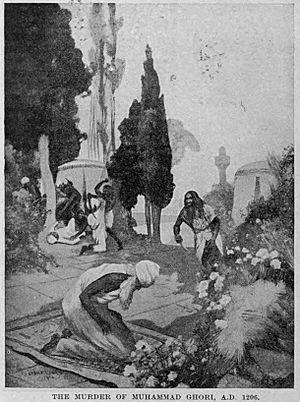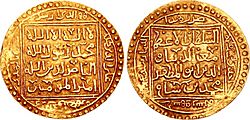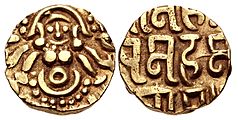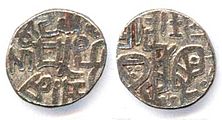Muhammad of Ghor facts for kids
Quick facts for kids Muhammad of Ghor |
|
|---|---|
| Malik Shihabuddin Muizzuddin |
|
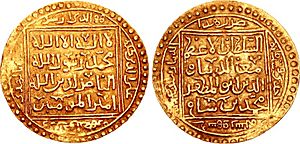
Gold coin of Muhammad of Ghor from Ghazni, for circulation in Central Asia and what is present-day Afghanistan
|
|
| Sultan of the Ghurid Empire | |
| Predecessor | Ghiyath al-Din Muhammad |
| Successor | Ghor: Ghiyath al-Din Mahmud Ghazni: Taj ad-Din Yildiz Lahore: Qutbu l-Din Aibak Bengal: Muhammad bin Bakhtiyar Khilji Multan: Nasir-ud-Din Qabacha |
| Reign | 1173–1203 (with his brother Ghiyath al-Din Muhammad) |
| Reign | 1203–1206 (as sole ruler) |
| Born | 1144 Ghor, Ghurid Empire (present-day Afghanistan) |
| Died | 15 March 1206 (aged 60–61) Dhamiak, Jhelum District, Ghurid Empire (present-day Pakistan) |
| Burial | Ghazna (present-day Afghanistan) |
| House | Ghurid dynasty |
| Father | Baha al-Din Sam I |
| Religion | Sunni Islam |
Muhammad of Ghor (born 1144 – died March 15, 1206) was an important ruler from the Ghurid dynasty. This dynasty was based in what is now Afghanistan. Muhammad of Ghor ruled from 1173 to 1206.
He ruled alongside his older brother, Ghiyath al-Din Muhammad. Together, they made the Ghurid Empire very large. Muhammad of Ghor expanded the empire eastward. He helped start Muslim rule in the Indian Subcontinent. This rule lasted for nearly 500 years after him.
Contents
Early Life and Rise to Power
Muhammad of Ghor was born in the Ghur region. This area is now part of Afghanistan. His father was Baha al-Din Sam I, a Ghurid ruler. Muhammad was a child when his father died in 1149.
His early years were quite difficult. He and his brother were even imprisoned by their uncle, Ala al-Din Husayn. They were later freed by their cousin, Sayf al-Din Muhammad.
Becoming a Ruler
After being freed, Muhammad helped his brother, Ghiyath al-Din. His brother became the ruler in 1163. Muhammad was first a minor officer. But later, he was put in charge of the southern parts of the Ghurid lands.
As a prince, Muhammad fought against the Oghuz tribes. He used Qandhar as a base for his attacks. He and his brother defeated them and captured Ghazni in 1169. Muhammad was crowned in Ghazni in 1173.
In 1175, Muhammad helped his brother take over Herat and Pushang. They also brought the Nasrid dynasty of Sistan under their control. After this, Muhammad turned his attention to the Indian subcontinent.
Invasions of India
Muhammad of Ghor began his military campaigns in the Indian subcontinent in 1175.
First Campaigns
His first attacks were against the Qarmatians in Multan. He defeated their ruler in 1175 and took over Multan. This was a big blow to the Qarmatian power there.
After Multan, Muhammad captured Uch in 1176. Uch was an important city located where the Chenab and Jhelum rivers meet.
Muhammad then tried to enter India through Gujarat in 1178. His army marched through the dry Thar Desert. They were tired and hungry when they reached Mount Abu. There, a group of Rajput chiefs, led by Mularaja II, defeated them. This loss made Muhammad change his plans for future attacks. He decided to focus on northern routes.
Taking Over Punjab
In 1179, Muhammad of Ghor conquered Peshawar. He then moved towards Lahore in 1181. The ruler of Lahore, Khusrau Malik, tried to keep him away by sending gifts.
In 1182, Muhammad took over Sindh. He expanded his control around present-day Pakistan. He captured Sialkot and attacked Lahore. Finally, in 1186, he launched a big attack on Lahore. He forced Khusrau Malik to surrender. Muhammad then imprisoned Khusrau Malik and his family, who were later executed. This ended the rule of the Ghaznavids.
After this victory, Muhammad of Ghor controlled the upper Indus Plain and most of Punjab. He appointed officials to manage these new lands.
First Battle of Tarain
In 1190, Ghurid generals began raiding eastern Punjab. They captured a fort called Bathinda. Prithviraj Chauhan, a powerful Rajput king, sent his army to fight back.
The two armies met in 1191 near Tarain, close to Delhi. The Ghurid forces were defeated. Muhammad himself was wounded in the battle. His army had to retreat, and Prithviraj's army won.
Second Battle of Tarain
After his defeat, Muhammad of Ghor punished his generals who had fled. He vowed to get revenge. In 1192, he returned with a huge army of Turkish archers.
The Ghurids attacked the Rajput army before dawn. The Rajputs were surprised and suffered heavy losses. Muhammad's army won a decisive victory. Prithviraj was captured and later executed.
After this win, the Ghurids took over Ajmer and other areas. Muhammad placed strong garrisons in important military spots. He also put Prithviraj's young son in charge as a puppet ruler, meaning he ruled under Muhammad's control.
Soon after, Delhi was also captured by Muhammad of Ghor and his general Qutb ud-Din Aibak in 1192. Muhammad then focused on other parts of his empire. He left his slave generals, like Aibak, to manage and expand his rule in India. These generals quickly raided local kingdoms. They expanded the Ghurid influence as far east as Bengal.
More Campaigns in India
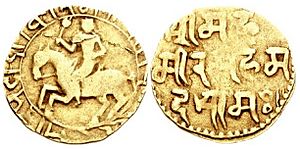
Obverse: Horseman with Nagari legend around: samvat 1262 bhadrapada "August, year 1262". Reverse: Nagari legend: srima ha/ mira mahama /da saamah "Lord Emir Mohammed [ibn] Sam".
In 1194, Muhammad of Ghor returned to India. He crossed the Jamuna river with 50,000 horsemen. He defeated the Gahadavala king Jayachandra in a battle near Jumna. Jayachandra was killed.
The Ghurids then attacked Benaras, a Hindu pilgrim center. They also captured the castle of Asni, taking its royal treasure. The Gahadavala capital Kanauj was taken in 1198. The Buddhist city of Sarnath was also attacked during this campaign.
Around 1196, Muhammad of Ghor returned to the Indian frontier. He wanted to strengthen his control in Rajasthan. He and Aibak besieged Thankar and defeated its ruler. Muhammad placed the fort under his slave general Baha-ur din Tughril. Tughril later captured the fort of Gwalior.
In 1197, Qutb ud-Din Aibak invaded Gujarat. He defeated Bhima II and sacked his capital Anhilwara. This was revenge for Muhammad of Ghor's defeat there in 1178.
Challenges in Central Asia
After his brother died in 1203, Muhammad of Ghor became the sole ruler of the Ghurid Empire. He faced challenges from the Khwarazmian Empire.
He suffered a big defeat in the Battle of Andkhud in 1204. This was against the Qara-Khitai forces, who were helping the Khwarazmians. As a result, the Ghurid power weakened in many parts of Khurasan.
Muhammad put down rebellions that started after this defeat. He planned to invade Transoxiana to get revenge. However, a rebellion by the Khokhars forced him to go to Punjab instead.
Final Days and Assassination
Muhammad of Ghor brutally crushed the Khokhar revolt during his last campaign.
On his way back to Ghazni, Muhammad of Ghor was assassinated. This happened on March 15, 1206, at Dhamiak, near Jhelum in present-day Pakistan. He was killed by a group of assassins while he was praying. Some accounts say they were from a rival Ismaili group.
His death ended the Ghurid Empire's main power. His successors became weaker. The Khwarazmians eventually took over the Ghurids by 1215. However, Muhammad of Ghor's conquests in India continued to thrive. His slave commander, Qutb ud-Din Aibak, established the Mamluk dynasty (also known as the Delhi Sultanate).
Succession and Legacy
Muhammad of Ghor had no surviving children. His sudden death led to a power struggle among his generals and other Ghurid leaders. His nephew, Ghiyath al-Din Mahmud, eventually became his successor in 1206.
However, most of Muhammad's conquests in India were controlled by his slave generals. These included Qutb ud-Din Aibak, Taj al-Din Yildiz, and Nasir ad-Din Qabacha. They barely consulted Mahmud.
Mahmud officially freed Aibak and Yildiz from slavery. Yildiz became king of Ghazni in 1206. Aibak declared independence in Lahore in 1208 and established the Delhi Sultanate. This new sultanate became a major Islamic state. It survived the Mongol invasions that destroyed many other states in Central Asia.
Relationship with His Slaves
Muhammad of Ghor bought many slaves during his life. These slaves later became very famous for their skills. He treated them like his own sons and future leaders. This was because he was disappointed with his own family later in life.
His slaves played a key role in expanding his empire in India. They gained authority in northern India while still seeing Muhammad of Ghor as their supreme leader. Muhammad also arranged marriages among his slaves' families. For example, the daughters of Taj al-Din Yildiz married Qutb ud-Din Aibak and Nasir ad-Din Qabacha.
Impact of His Rule
During his rule with his brother, the Ghurids became one of the most powerful empires in the eastern Islamic world. Their empire stretched over 3,000 kilometers from east to west. Muhammad of Ghor's empire reached from eastern Iran to Varanasi and Bengal in India. It also went from the Himalayas south to Sindh.
His big victory in the Second Battle of Tarain opened up the entire Ganges Basin to Turkic rule. This led to the creation of the Delhi Sultanate. The Delhi Sultanate was further strengthened by his slave commander Iltutmish.
The Ghor region itself also grew during his reign. It became an important center for learning and culture. Muhammad also supported religious scholars. He also contributed to architecture, building unique Islamic glazed tiles in his capital, Ghazni.
Memorials

A shrine for Muhammad Ghori was built in Dhamiak, Pakistan, in 1994-1995. However, Muhammad Ghori was actually buried in his daughter's mausoleum in Ghazni.
The Pakistani military named three of its medium-range ballistic missiles after him: Ghauri-I, Ghauri-II, and Ghauri-III.
Coins
-
Traditional gold coins of Muhammad of Ghor from Ghazna for the circulation in Central Asia and Afghanistan
During his rule, Muhammad of Ghor minted coins. In Central Asia and Afghanistan, his coins were traditional Islamic ones. They had no images, only his name in Arabic and Persian.
However, the coins he used in North India were different. In Delhi, his coins continued the existing style. They had images of a Nandi Bull and a "Chahaman horseman." His name was written as "Shri Hammirah." His gold coins in North India even had the image of the Hindu goddess Lakshmi on one side. His name was written in Nāgarī script (Sanskrit) on the other side.
Historians believe that local Indian bankers accepted Muhammad of Ghor's coins just as easily as the previous Rajput coins. This shows a smooth change in the money system during his rule.
See also
 In Spanish: Muhammad de Gur para niños
In Spanish: Muhammad de Gur para niños



